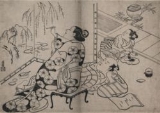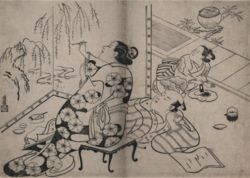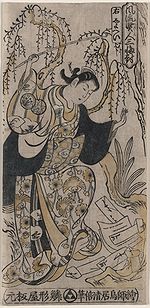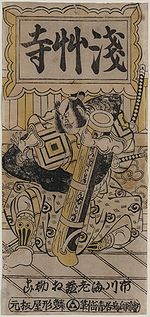
Torii school
Encyclopedia
This article is about a school of ukiyo-e art; for the sculpture style, see Tori style
. For the Torii samurai clan, see Torii family
.
The Torii school (鳥居派, -ha) was a school of ukiyo-e
painting and printing founded in Edo
. The primary producers of kabuki
theater signboards and other promotional materials, the Torii were among those whose work led to the development of ukiyo-e. Their style was one of the primary influences in the ukiyo-e depiction of actors and kabuki scenes for much of the 18th century. Still today, kabuki signboards are sometimes painted by members of the Torii family.
 The Torii style truly emerged with Torii Kiyonobu, who came to Edo in 1687. The Torii family had already been active in the kabuki world, in Osaka, for several generations at this point. He studied under Yoshida Hanbei
The Torii style truly emerged with Torii Kiyonobu, who came to Edo in 1687. The Torii family had already been active in the kabuki world, in Osaka, for several generations at this point. He studied under Yoshida Hanbei
and Hishikawa Moronobu
, and brought a kabuki sensibility to their artistic styles. Moronobu's work was already dramatic and energetic, but Kiyonobu added to this with a further emphasis on action, and on the types of poses (see mie
) and aesthetics one would see on the kabuki stage. For many years, Kiyonobu and his actor father Torii Kiyomoto
produced primarily theater signboards, book illustrations, and promotional materials for the theaters.
It was not until 1700 that the Torii began to create full-size paintings and prints that could be interpreted as independent works of art. Of course, many still depicted actors and the kabuki world, and could therefore be construed as serving as promotional materials. But by this time Kiyonobu, and his successor Torii Kiyonobu II, were also producing paintings and prints of courtesans, erotic scenes
, and sumo
.
Even as the Torii school expanded, and began to produce works in the increasingly popular form of paintings and prints, the core purpose of the clan remained the production of billboards, posters, and other theatrical works. As such, Kiyonobu, and the heads of the clan after him, worked primarily on these types of works, leaving relatively few paintings and prints.
 Torii Kiyomasu
Torii Kiyomasu
, and his successors, would represent something of a departure from the theatrical and energetic core style of the Torii school. Taking Sugimura Jihei
as a role model, rather than Moronobu, Kiyomasu produced works far softer, more delicate and graceful than those of many other Torii artists. Nevertheless, it is interesting that many works by these other artists, who produced more dramatic works in Kiyonobu's style, are signed "Kiyomasu."
Even as other schools and styles emerged over the course of the 18th century, the Torii style remained at the core of ukiyo-e. It was something every artist had to either embrace and elaborate on, or to reject entirely. The Torii style, even in paintings and prints, continued to be derived directly from the clan's work for the kabuki theaters. Their style was bombastic, dramatic, and somewhat idealized. One of the primary elements of their particular style was the use of bold, thick lines, attracting the eye of the viewer, and giving the composition an overall boldness. This element was embraced by a number of artists, particularly the Kaigetsudō school
.
 Torii Kiyonobu II and Kiyomasu II
Torii Kiyonobu II and Kiyomasu II
, the second generation of the school, saw it to its climax. Both artists were active from the 1720s to the 1760s, and consolidated the bolder style of Kiyonobu with the more graceful, delicate style of Kiyomasu. They helped develop the Torii style away from the early, primitive forms of Moronobu and into something that formed a key part of the mainstream style of ukiyo-e. They also, however, experimented with the use of urushi-e
, using lacquer for deeper, bolder lines, and brass or other metal dust to add a sparkle to their works.
The works of Torii Kiyohiro, Kiyomitsu
, and Kiyotsune, all active in the 1750s to 1770s, continued the tradition of their forbears. By this point, the school more or less defined the core of mainstream ukiyo-e style. These artists' figures are more graceful and delicate, and less bold, than those of their predecessors. But they were also some of the first to experiment with benizuri-e
, or "rose prints"; at this time, printers began to use color on the woodblocks, coloring the prints directly during production, instead of by hand afterwards. Up to five different colors could be used in one print, but the overall effect was still far simpler than the nishiki-e (multicolored "brocade" prints) which would emerge later.
Katsukawa Shunshō
and Sharaku
, two of the greatest artists to reject the Torii style, pioneered attempts to represent the theater, and actors, realistically. They continued to instill a great degree of drama and bombast into their works, but showed actors as actors, not as the roles which they played. Most crucially, they depicted artists as individuals, representing facial features and actors' personalities such that each individual actor could be identified despite their role, and the makeup and costume that went with it. Though these artists were extremely successful, and eclipsed the Torii artists to some extent, the Torii remained influential and successful as well.
In the 1770s, Torii Kiyonaga
emerged as the new great artist of his time, bringing the Torii school back to the forefront, but presenting his own unique stylistic adaptations. Kiyonaga would come to be regarded one of the greatest of all ukiyo-e artists, but also the last of the great Torii artists. He retained much of the core of the Torii style, the drama, energy, and theatrical sensibility, but sought a degree of realism and individuality in his depictions of actors even beyond what Sharaku and Shunshō attained. He depicted the urban culture of Edo with a realism previously unseen, and is widely credited with perfecting or mastering many other elements of the ukiyo-e genre. However, he too retired from the world of prints to focus on the theater signboards which were the true work of the Torii school.
Though Kiyonaga is generally regarded as the final great master of the Torii school, the school continued to produce theater materials, paintings and prints; more importantly, Kiyonaga's style, and that of his predecessors, continued to influence the next wave of ukiyo-e artists.
Asuka period
The , was a period in the history of Japan lasting from 538 to 710 , although its beginning could be said to overlap with the preceding Kofun period...
. For the Torii samurai clan, see Torii family
Torii family
The Torii family was a samurai family of the late Sengoku and Edo periods of Japanese history. Loyal retainers of the Tokugawa clan since the late 16th century, the Torii are perhaps most famous for the bravery and valor of Torii Sune'emon, who was crucified by Takeda Katsuyori at the 1575 siege...
.
The Torii school (鳥居派, -ha) was a school of ukiyo-e
Ukiyo-e
' is a genre of Japanese woodblock prints and paintings produced between the 17th and the 20th centuries, featuring motifs of landscapes, tales from history, the theatre, and pleasure quarters...
painting and printing founded in Edo
Edo
, also romanized as Yedo or Yeddo, is the former name of the Japanese capital Tokyo, and was the seat of power for the Tokugawa shogunate which ruled Japan from 1603 to 1868...
. The primary producers of kabuki
Kabuki
is classical Japanese dance-drama. Kabuki theatre is known for the stylization of its drama and for the elaborate make-up worn by some of its performers.The individual kanji characters, from left to right, mean sing , dance , and skill...
theater signboards and other promotional materials, the Torii were among those whose work led to the development of ukiyo-e. Their style was one of the primary influences in the ukiyo-e depiction of actors and kabuki scenes for much of the 18th century. Still today, kabuki signboards are sometimes painted by members of the Torii family.
History

Yoshida Hanbei
Yoshida Hanbei was a late 17th century Japanese illustrator in the ukiyo-e style, the leading illustrator in Kyoto and Osaka around 1664-1689. Unlike many more famous ukiyo-e artists, who worked primarily on individual woodblock prints and paintings, Hanbei worked primarily, if not exclusively, in...
and Hishikawa Moronobu
Hishikawa Moronobu
was a Japanese painter and printmaker known for his advancement of the ukiyo-e woodcut style starting in the 1670s.-Early life and training:Moronobu was the son of a well-respected dyer and a gold and silver-thread embroiderer in the village of Hodamura, Awa Province, near Edo Bay. After moving to...
, and brought a kabuki sensibility to their artistic styles. Moronobu's work was already dramatic and energetic, but Kiyonobu added to this with a further emphasis on action, and on the types of poses (see mie
Mie
Mie may refer to:* KMIE, the ICAO code for the Delaware County Airport near Muncie, Indiana* Mie Prefecture, Japan* Mie District, Mie, a district of Japan* Mie, Ōita, a town of Japan* Mie University, a university in Tsu, Mie, Japan...
) and aesthetics one would see on the kabuki stage. For many years, Kiyonobu and his actor father Torii Kiyomoto
Torii Kiyomoto
was a kabuki actor from Osaka and painter of billboards and other kabuki advertisements; the founder of the Torii school of artists, he painted in what would come to be known as an early form of the ukiyo-e style. Onstage, he went by the name Torii Shōshichi....
produced primarily theater signboards, book illustrations, and promotional materials for the theaters.
It was not until 1700 that the Torii began to create full-size paintings and prints that could be interpreted as independent works of art. Of course, many still depicted actors and the kabuki world, and could therefore be construed as serving as promotional materials. But by this time Kiyonobu, and his successor Torii Kiyonobu II, were also producing paintings and prints of courtesans, erotic scenes
Shunga
' is a Japanese term for erotic art. Most shunga are a type of ukiyo-e, usually executed in woodblock print format. While rare, there are extant erotic painted handscrolls which predate the Ukiyo-e movement...
, and sumo
Sumo
is a competitive full-contact sport where a wrestler attempts to force another wrestler out of a circular ring or to touch the ground with anything other than the soles of the feet. The sport originated in Japan, the only country where it is practiced professionally...
.
Even as the Torii school expanded, and began to produce works in the increasingly popular form of paintings and prints, the core purpose of the clan remained the production of billboards, posters, and other theatrical works. As such, Kiyonobu, and the heads of the clan after him, worked primarily on these types of works, leaving relatively few paintings and prints.

Torii Kiyomasu
was a Japanese painter and printmaker of the Torii school, in the genre of ukiyo-e. Like the other Torii artists, his primary focus was on Kabuki billboards, advertisements, actor prints, and other related material...
, and his successors, would represent something of a departure from the theatrical and energetic core style of the Torii school. Taking Sugimura Jihei
Sugimura Jihei
was a Japanese ukiyo-e printmaker who flourished from approximately 1681 to 1703. A follower of Hishikawa Moronobu, Sugimura illustrated at least 70 books, and created a number of large size prints along with many of the more standard sizes and formats....
as a role model, rather than Moronobu, Kiyomasu produced works far softer, more delicate and graceful than those of many other Torii artists. Nevertheless, it is interesting that many works by these other artists, who produced more dramatic works in Kiyonobu's style, are signed "Kiyomasu."
Even as other schools and styles emerged over the course of the 18th century, the Torii style remained at the core of ukiyo-e. It was something every artist had to either embrace and elaborate on, or to reject entirely. The Torii style, even in paintings and prints, continued to be derived directly from the clan's work for the kabuki theaters. Their style was bombastic, dramatic, and somewhat idealized. One of the primary elements of their particular style was the use of bold, thick lines, attracting the eye of the viewer, and giving the composition an overall boldness. This element was embraced by a number of artists, particularly the Kaigetsudō school
Kaigetsudo school
The Kaigetsudō school was a school of ukiyo-e painting and printmaking founded in Edo around 1700-1714. It is often said that the various Kaigetsudō artists' styles are so similar, many scholars find it nearly impossible to differentiate them; thus, many Kaigetsudō paintings are attributed to the...
.

Torii Kiyomasu II
was a Japanese ukiyo-e painter and woodblock printmaker of the Torii school, a specialist, like the rest of the Torii artists, in billboards and other images for the promotion of the kabuki theatres...
, the second generation of the school, saw it to its climax. Both artists were active from the 1720s to the 1760s, and consolidated the bolder style of Kiyonobu with the more graceful, delicate style of Kiyomasu. They helped develop the Torii style away from the early, primitive forms of Moronobu and into something that formed a key part of the mainstream style of ukiyo-e. They also, however, experimented with the use of urushi-e
Urushi-e
Urushi-e , literally meaning "lacquer picture," refers to two types of Japanese artworks: paintings painted with actual lacquer, and particular woodblock printing styles which use regular ink but are said to resemble the darkness and thickness of black lacquer.-Prints:Urushi-e woodblock prints were...
, using lacquer for deeper, bolder lines, and brass or other metal dust to add a sparkle to their works.
The works of Torii Kiyohiro, Kiyomitsu
Torii Kiyomitsu
was a painter and printmaker of the Torii school of Japanese ukiyo-e art; the son of Torii Kiyonobu II or Torii Kiyomasu II, he was the third head of the school, and was originally called Kamejirō before taking the gō Kiyomitsu...
, and Kiyotsune, all active in the 1750s to 1770s, continued the tradition of their forbears. By this point, the school more or less defined the core of mainstream ukiyo-e style. These artists' figures are more graceful and delicate, and less bold, than those of their predecessors. But they were also some of the first to experiment with benizuri-e
Benizuri-e
' are a type of “primitive” ukiyo-e style Japanese woodblock prints. They were usually printed in pink and green, occasionally with the addition of another color, either printed or added by hand. The production of benizuri-e reached its peak in the early 1740s...
, or "rose prints"; at this time, printers began to use color on the woodblocks, coloring the prints directly during production, instead of by hand afterwards. Up to five different colors could be used in one print, but the overall effect was still far simpler than the nishiki-e (multicolored "brocade" prints) which would emerge later.
Katsukawa Shunshō
Katsukawa Shunsho
was a Japanese painter and printmaker in the ukiyo-e style, and the leading artist of the Katsukawa school. Shunshō studied under Miyagawa Shunsui, son and student of Miyagawa Chōshun, both equally famous and talented ukiyo-e artists. Shunshō is most well known for introducing a new form of...
and Sharaku
Sharaku
is widely considered to be one of the great masters of the woodblock printing in Japan. Little is known of him, besides his ukiyo-e prints; neither his true name nor the dates of his birth or death are known with any certainty...
, two of the greatest artists to reject the Torii style, pioneered attempts to represent the theater, and actors, realistically. They continued to instill a great degree of drama and bombast into their works, but showed actors as actors, not as the roles which they played. Most crucially, they depicted artists as individuals, representing facial features and actors' personalities such that each individual actor could be identified despite their role, and the makeup and costume that went with it. Though these artists were extremely successful, and eclipsed the Torii artists to some extent, the Torii remained influential and successful as well.
In the 1770s, Torii Kiyonaga
Torii Kiyonaga
This article is about the ukiyo-e artist; for samurai named Kiyonaga, see Naito Kiyonaga and Koriki Kiyonaga. was a Japanese ukiyo-e printmaker and painter of the Torii school. Originally Sekiguchi Shinsuke, the son of an Edo bookseller, he took on Torii Kiyonaga as an art-name...
emerged as the new great artist of his time, bringing the Torii school back to the forefront, but presenting his own unique stylistic adaptations. Kiyonaga would come to be regarded one of the greatest of all ukiyo-e artists, but also the last of the great Torii artists. He retained much of the core of the Torii style, the drama, energy, and theatrical sensibility, but sought a degree of realism and individuality in his depictions of actors even beyond what Sharaku and Shunshō attained. He depicted the urban culture of Edo with a realism previously unseen, and is widely credited with perfecting or mastering many other elements of the ukiyo-e genre. However, he too retired from the world of prints to focus on the theater signboards which were the true work of the Torii school.
Though Kiyonaga is generally regarded as the final great master of the Torii school, the school continued to produce theater materials, paintings and prints; more importantly, Kiyonaga's style, and that of his predecessors, continued to influence the next wave of ukiyo-e artists.
Significant artists of the school
- Torii KiyomotoTorii Kiyomotowas a kabuki actor from Osaka and painter of billboards and other kabuki advertisements; the founder of the Torii school of artists, he painted in what would come to be known as an early form of the ukiyo-e style. Onstage, he went by the name Torii Shōshichi....
- Torii Kiyonobu ITorii Kiyonobu Iwas a Japanese painter and printmaker in the ukiyo-e style, who is renowned for his work on Kabuki signboards and related materials. Along with his father Torii Kiyomoto, he is said to have been one of the founders of the Torii school of painting....
- Torii Kiyonobu II
- Torii Kiyomasu ITorii Kiyomasuwas a Japanese painter and printmaker of the Torii school, in the genre of ukiyo-e. Like the other Torii artists, his primary focus was on Kabuki billboards, advertisements, actor prints, and other related material...
- Torii Kiyomasu IITorii Kiyomasu IIwas a Japanese ukiyo-e painter and woodblock printmaker of the Torii school, a specialist, like the rest of the Torii artists, in billboards and other images for the promotion of the kabuki theatres...
- Torii Kiyotada
- Torii Kiyoshige
- Torii Kiyohiro (Wikimedia commons)
- Torii KiyomitsuTorii Kiyomitsuwas a painter and printmaker of the Torii school of Japanese ukiyo-e art; the son of Torii Kiyonobu II or Torii Kiyomasu II, he was the third head of the school, and was originally called Kamejirō before taking the gō Kiyomitsu...
- Torii Kiyotsune
- Torii KiyonagaTorii KiyonagaThis article is about the ukiyo-e artist; for samurai named Kiyonaga, see Naito Kiyonaga and Koriki Kiyonaga. was a Japanese ukiyo-e printmaker and painter of the Torii school. Originally Sekiguchi Shinsuke, the son of an Edo bookseller, he took on Torii Kiyonaga as an art-name...

